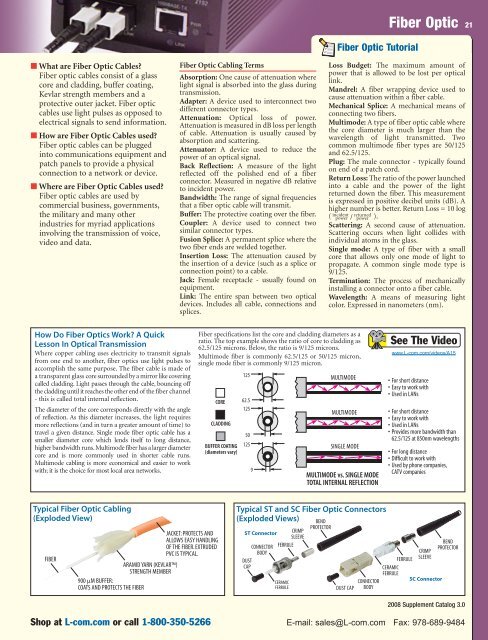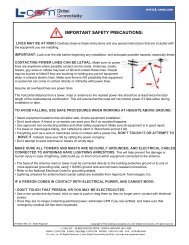pages - 14mb
pages - 14mb
pages - 14mb
Create successful ePaper yourself
Turn your PDF publications into a flip-book with our unique Google optimized e-Paper software.
■ What are Fiber Optic Cables?<br />
Fiber optic cables consist of a glass<br />
core and cladding, buffer coating,<br />
Kevlar strength members and a<br />
protective outer jacket. Fiber optic<br />
cables use light pulses as opposed to<br />
electrical signals to send information.<br />
■ How are Fiber Optic Cables used?<br />
Fiber optic cables can be plugged<br />
into communications equipment and<br />
patch panels to provide a physical<br />
connection to a network or device.<br />
■ Where are Fiber Optic Cables used?<br />
Fiber optic cables are used by<br />
commercial business, governments,<br />
the military and many other<br />
industries for myriad applications<br />
involving the transmission of voice,<br />
video and data.<br />
Fiber Optic Cabling Terms<br />
Absorption: One cause of attenuation where<br />
light signal is absorbed into the glass during<br />
transmission.<br />
Adapter: A device used to interconnect two<br />
different connector types.<br />
Attenuation: Optical loss of power.<br />
Attenuation is measured in dB loss per length<br />
of cable. Attenuation is usually caused by<br />
absorption and scattering.<br />
Attenuator: A device used to reduce the<br />
power of an optical signal.<br />
Back Reflection: A measure of the light<br />
reflected off the polished end of a fiber<br />
connector. Measured in negative dB relative<br />
to incident power.<br />
Bandwidth: The range of signal frequencies<br />
that a fiber optic cable will transmit.<br />
Buffer: The protective coating over the fiber.<br />
Coupler: A device used to connect two<br />
similar connector types.<br />
Fusion Splice: A permanent splice where the<br />
two fiber ends are welded together.<br />
Insertion Loss: The attenuation caused by<br />
the insertion of a device (such as a splice or<br />
connection point) to a cable.<br />
Jack: Female receptacle - usually found on<br />
equipment.<br />
Link: The entire span between two optical<br />
devices. Includes all cable, connections and<br />
splices.<br />
Fiber Optic Tutorial<br />
Fiber Optic 21<br />
Loss Budget: The maximum amount of<br />
power that is allowed to be lost per optical<br />
link.<br />
Mandrel: A fiber wrapping device used to<br />
cause attenuation within a fiber cable.<br />
Mechanical Splice: A mechanical means of<br />
connecting two fibers.<br />
Multimode: A type of fiber optic cable where<br />
the core diameter is much larger than the<br />
wavelength of light transmitted. Two<br />
common multimode fiber types are 50/125<br />
and 62.5/125.<br />
Plug: The male connector - typically found<br />
on end of a patch cord.<br />
Return Loss: The ratio of the power launched<br />
into a cable and the power of the light<br />
returned down the fiber. This measurement<br />
is expressed in positive decibel units (dB). A<br />
higher number is better. Return Loss = 10 log<br />
(<br />
incident returned<br />
power / power ).<br />
Scattering: A second cause of attenuation.<br />
Scattering occurs when light collides with<br />
individual atoms in the glass.<br />
Single mode: A type of fiber with a small<br />
core that allows only one mode of light to<br />
propagate. A common single mode type is<br />
9/125.<br />
Termination: The process of mechanically<br />
installing a connector onto a fiber cable.<br />
Wavelength: A means of measuring light<br />
color. Expressed in nanometers (nm).<br />
How Do Fiber Optics Work? A Quick<br />
Lesson In Optical Transmission<br />
Where copper cabling uses electricity to transmit signals<br />
from one end to another, fiber optics use light pulses to<br />
accomplish the same purpose. The fiber cable is made of<br />
a transparent glass core surrounded by a mirror like covering<br />
called cladding. Light passes through the cable, bouncing off<br />
the cladding until it reaches the other end of the fiber channel<br />
- this is called total internal reflection.<br />
The diameter of the core corresponds directly with the angle<br />
of reflection. As this diameter increases, the light requires<br />
more reflections (and in turn a greater amount of time) to<br />
travel a given distance. Single mode fiber optic cable has a<br />
smaller diameter core which lends itself to long distance,<br />
higher bandwidth runs. Multimode fiber has a larger diameter<br />
core and is more commonly used in shorter cable runs.<br />
Multimode cabling is more economical and easier to work<br />
with; it is the choice for most local area networks.<br />
Fiber specifications list the core and cladding diameters as a<br />
ratio. The top example shows the ratio of core to cladding as<br />
62.5/125 microns. Below, the ratio is 9/125 microns.<br />
Multimode fiber is commonly 62.5/125 or 50/125 micron,<br />
single mode fiber is commonly 9/125 micron.<br />
CORE<br />
CLADDING<br />
BUFFER COATING<br />
(diameters vary)<br />
125<br />
62.5<br />
125<br />
50<br />
125<br />
9<br />
MULTIMODE<br />
MULTIMODE<br />
SINGLE MODE<br />
MULTIMODE vs. SINGLE MODE<br />
TOTAL INTERNAL REFLECTION<br />
www.L-com.com/videos/A15<br />
• For short distance<br />
• Easy to work with<br />
• Used in LANs<br />
• For short distance<br />
• Easy to work with<br />
• Used in LANs<br />
• Provides more bandwidth than<br />
62.5/125 at 850nm wavelengths<br />
• For long distance<br />
• Difficult to work with<br />
• Used by phone companies,<br />
CATV companies<br />
Typical Fiber Optic Cabling<br />
(Exploded View)<br />
FIBER<br />
900 µM BUFFER:<br />
COATS AND PROTECTS THE FIBER<br />
JACKET: PROTECTS AND<br />
ALLOWS EASY HANDLING<br />
OF THE FIBER. EXTRUDED<br />
PVC IS TYPICAL.<br />
ARAMID YARN (KEVLAR)<br />
STRENGTH MEMBER<br />
Shop at L-com.com or call 1-800-350-5266<br />
E-mail: sales@L-com.com Fax: 978-689-9484<br />
Typical ST and SC Fiber Optic Connectors<br />
(Exploded Views)<br />
ST Connector CRIMP<br />
SLEEVE<br />
CONNECTOR FERRULE<br />
BODY<br />
DUST<br />
CAP<br />
Shop at L-com.com or call 1-800-350-5266 E-mail: sales@L-com.com Fax: 978-689-9484<br />
CERAMIC<br />
FERRULE<br />
BEND<br />
PROTECTOR<br />
DUST CAP<br />
CONNECTOR<br />
BODY<br />
FERRULE<br />
CERAMIC<br />
FERRULE<br />
CRIMP<br />
SLEEVE<br />
SC Connector<br />
BEND<br />
PROTECTOR<br />
2008 Supplement Catalog 3.0



